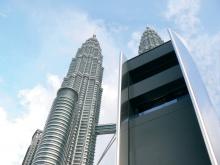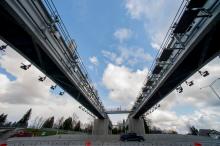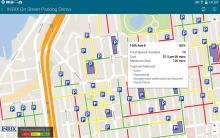Collection of traffic and transit data has grown significantly, combining with advances in connectivity and computational modelling to good effect. Desire to do more with less – to make budgets go further – has helped create a boom in the collection and study of traffic and transport data. Studies are becoming longer, greater in number and further in-depth as more intelligence is sought, plus, transportation agencies are looking to make processes of data collection less costly, or more efficient.

Sophisticated demand prediction modelling is being used to support dynamic pricing of parking spaces in Los Angeles
Collection of traffic and transit data has grown significantly, combining with advances in connectivity and computational modelling to good effect.
Desire to do more with less – to make budgets go further – has helped create a boom in the collection and study of traffic and transport data. Studies are becoming longer, greater in number and further in-depth as more intelligence is sought, plus, transportation agencies are looking to make processes of data collection less costly, or more efficient.This is according to those collecting and crunching the data to produce useable information. Cursory inspection of the work they are now undertaking reveals that advances in methods and available technology are also playing significant roles in expanding data analysis as a science of transportation.
A company whose growth has mirrored this expansion is
Smooth operations
“Everyone is looking for ways to streamline their operations, to increase the efficiency, reliability and accuracy of the way they collect data,” says Miovision’s CEO and co-founder Kurtis McBride. “Automated collection is more reliable and accurate and cuts down on manpower.” Plus, the company has launched an ‘On-Demand’ service, whereby clients can order a specific traffic data collection or study to be carried out by Miovision without any purchase of their own equipment. “This is good for smaller agencies or those not able to allocate resources for the task,” McBride says.“Traditionally, the transportation industry has not altered rapidly, but in the last two years or so, there has been more of a buzz about changes coming; talk has been about greater emergence of ITS in general and permanent systems for gathering and disseminating information in particular.
We are at the forefront of a charge for video data collection. When we launched our data service it was the first in transportation to be internet-based, but a number of others have been introduced to the market since, to take advantage of more connectivity through wireless networks.”
Miovision now carries out “more studies in a week than most do in a year”, McBride says. While the company would like to be able to claim that its growth is purely down to innovative Miovision technology, other suppliers have experienced similar, suggesting greater demand for automated data collection overall.
“There is a trend towards more clients collecting for longer studies, as there is a general acceptance that technology allows more representative samples,” says McBride. “Greater data provides further opportunity for organisations to use more sophisticated ways of pulling information from it, and the cheaper we can make it, the better the info that agencies will hold.”
Seeking services
Another firm handling a lot of data on behalf of transportation agencies is“Many are seeking data services that track travel trends over the long term for planning purposes, but are frustrated or finding difficulties with maintaining sensors in the field, compounded by institutional complexities of managing networks of such equipment,” Petty says. “So either companies are being paid to manage sensor networks, or agencies are purchasing data gathered by third parties. We are also finding consolidation of different monitoring programmes into centralised packages.”
An example of this is in production of ‘state of the system’ reports on transportation networks not by conventional means of commissioning full annual studies, but by extracting data from other established sources at less cost. Likewise, monitoring and planning highway recovery or maintenance patrols – for generating optimum routes – can be done by sourcing data from systems monitoring the performance of networks.
“We’ve noticed transportation departments’ development of data and use of IterisPeMS is being driven by their partners. Many more isolated communities are monitoring and reporting, using and feeding into systems provided centrally by state departments. We are also seeing a huge amount of different ‘dashboard’ requirements; various ways of displaying and comparing data.”
Extracting value
Accurate prediction of travel demand represents a pinnacle of network management for transportation agencies and as such presents potential for extracting greatest value from data collected. Prediction can be done in a number of ways, says Petty.IterisPeMS provides this to a certain level of accuracy based on historic data, but for greatest confidence, computational modelling is needed, calibrated to as many parameters as possible, such as ‘distance to car in front’. Models with similar levels of complexity are being used to build decision support systems of Integrated Corridor Management pilot projects in Dallas and San Diego.
“Complex questions can be asked of these models, but for this they have to be calibrated,” Petty says. “The game is about setting computational constants, observing what happens in reality compared with the predictions and then adjusting the parameters until the match is sufficiently exact.”
It would seem there is a lot more that agencies could be doing to exploit similar techniques of ‘predictive analytics’. This is a scientific arm of transportation that researchers at
“In Los Angeles, sophisticated demand prediction modelling is being used to support dynamic pricing of parking spaces. In public transport, origin and destination data is being used to analyse and model trips, to optimise routes for catching more people that would otherwise use a car. Cities are getting excited by the possibilities of this sort of data analysis.”
Improving performance
One Xerox research team has been studying demand prediction in dynamic pricing of freeflow tolling and high occupancy toll (HOT) lanes – studying how pricing can be adjusted dynamically, to anticipate demand for optimising throughput and service for customers.Xerox’s chief technology officer is Natesh Manikoth: “This is an interesting problem and I think there is a lot more to be done on it overall. We can get better at it. Instead of setting pricing from data on the situation already developed, greater use of predictive analytics combined with in-vehicle information systems would improve HOT lane performance and produce a more seamless experience for drivers,” he says.
“Other agencies may have different aims, such as maximising welfare, convenience or maximising revenue in the commercial world, but the principles of how the models apply are the same,” Manikoth adds. “For authorities or transportation operators interested in intermodal behaviour, how do they get more people onto public transport? What we are really trying to do is figure out what value people place on things. How much do they value their time? Imagine the power given to policymakers if they really could influence travel decisions and make it easy for people to change.”










